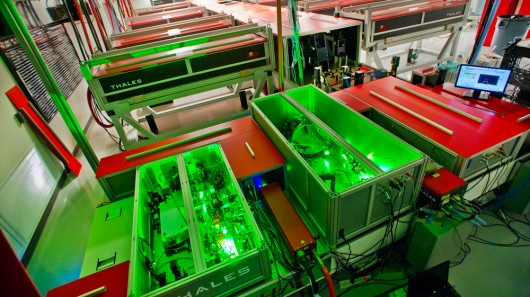Superfast laser delivers record-breaking peak power of one petawatt
03:59 August 8, 2012

The BELLA laser during construction at Berkeley Lab. It recently delivered a record-breaking petawatt in a pulse just 40 femtoseconds long at a rate of one pulse per second
Not even a month since researchers at the Lawrence Livermore National Laboratory's National Ignition Facility (NIF) announced a 500 trillion watt laser shot, researchers at the Berkeley Lab Laser Accelerator (BELLA) have managed to deliver a record-breaking petawatt, that is, a quadrillion watts, in a pulse just 40 femtoseconds long at a rate of one pulse every second. To put that in perspective, a petawatt is more than the combined output of all electric power plants in the world at any given time and one femtosecond is a quadrillionth of a second.
The BELLA design draws on years-long laser plasma accelerator research conducted by the Lasers and Optical Accelerator Systems Integrated Studies (LOASIS) program at the U.S. Department of Energy’s Lawrence Berkeley National Laboratory. Whereas conventional accelerators use modulated electric fields to accelerate charged particles such as protons and electrons, the laser plasma accelerator generates waves of electron density that move through a plasma. The laser beams either heat and drill through a plume of gas or they drive through plasma enclosed in a thin capillary in a sapphire. The extreme speed is achieved when the waves traps some of the plasma’s free electrons and accelerate them to very high energy levels within very short lengths.
The project’s initial experiments, scheduled to begin in the (northern hemisphere) autumn, will try to deliver the powerful pulses needed to create 10-billion-electron-volt (10 GeV) beams in a compact accelerator just one meter long (3.28 ft), although the laser system fills an adjacent room. For the sake of comparison, previous technology required a linear accelerator two miles long (3.2 km), as was the case with the Stanford Linear Accelerator Center, which achieved 50 GeV electron beams with traditional technology.
Compact accelerators can open up new possibilities for doctors, universities and industry to use them as tools for advanced treatments and research techniques, besides paving the way to the next generation of particle colliders for high energy physics.
Ed's note: This article was amended on August 8. It previously stated that the laser achieved a power of 1 petawatt per second, which is incorrect.
Source: Berkeley Lab
Copyright © gizmag 2003 - 2012 To subscribe or visit go to: http://www.gizmag.com